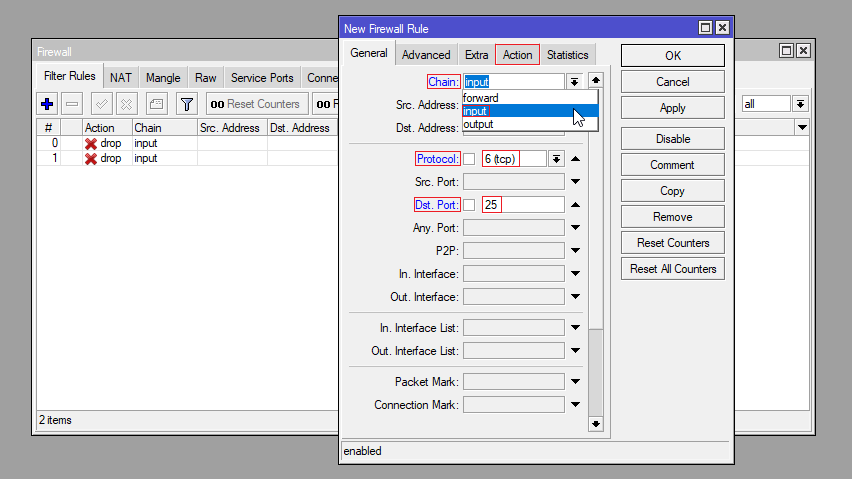


Each rule consists of two parts - the matcher which matches traffic flow against given conditions and the action which defines what to do with the matched packet.įirewall filtering rules are grouped together in chains. The firewall operates by means of firewall rules. rate at which packets arrive and sequence numbers.interface the packet arrived from or left through.protocol options (ICMP type and code fields, TCP flags, IP options and MSS).IP addresses (network or list) and address types (broadcast, local, multicast, unicast).MikroTik RouterOS has very powerful firewall implementation with features including: Properly configured firewall plays a key role in efficient and secure network infrastrure deployment. Firewalls are used as a means of preventing or minimizing the security risks inherent in connecting to other networks. Such break-ins may result in private data being stolen and distributed, valuable data being altered or destroyed, or entire hard drives being erased. Whenever different networks are joined together, there is always a threat that someone from outside of your network will break into your LAN. Network firewalls keep outside threats away from sensitive data available inside the network. Along with the Network Address Translation it serves as a tool for preventing unauthorized access to directly attached networks and the router itself as well as a filter for outgoing traffic.


There is another similar forum called super user which would be more appropriate for this kind of question.The firewall implements packet filtering and thereby provides security functions that are used to manage data flow to, from and through the router. I don't think this is something I could explain over StackOverflow though.Īlso - this answer is getting down voted since it's off topic since it relates to general computing and not programming. To properly do this, you'd actually need a separate VLAN or the a Mikrotik/Linux VM connected to both private network and LAN network acting as the firewall between. HOWEVER PLEASE NOTE THIS DOES NOT ACTUALLY PREVENT A COMPETENT ATTACKER WITH ROOT ACCESS ON THE LINUX VM FROM ACCESSING YOUR LAN. Then you can set firewall rules in Mikrotik to block traffic between 192.168.2.1 and 192.168.1.1 What you could do, on Mikrotik, is create another ipv4 address in another subnet (eg 192.168.2.1/24 if 192.168.1.1/24 is your main) and set up a static DHCP lease for your Ubuntu VM's MAC so it gets the address 192.168.2.50/24 and uses 192.168.2.1 for it's default gateway. The requested destination host will reply with it's MAC address and the two hosts communicate directly without the router. What happens is the VM's IP stack will send an ARP request - ARP WHO HAS to the broadcast address in the same subnet. If you have Ubuntu in a VMware VM, and it's connected to via bridged networking, it will by nature of IPv4 be able to reach everything in the same subnet/layer2 domain without going going to the router.


 0 kommentar(er)
0 kommentar(er)
